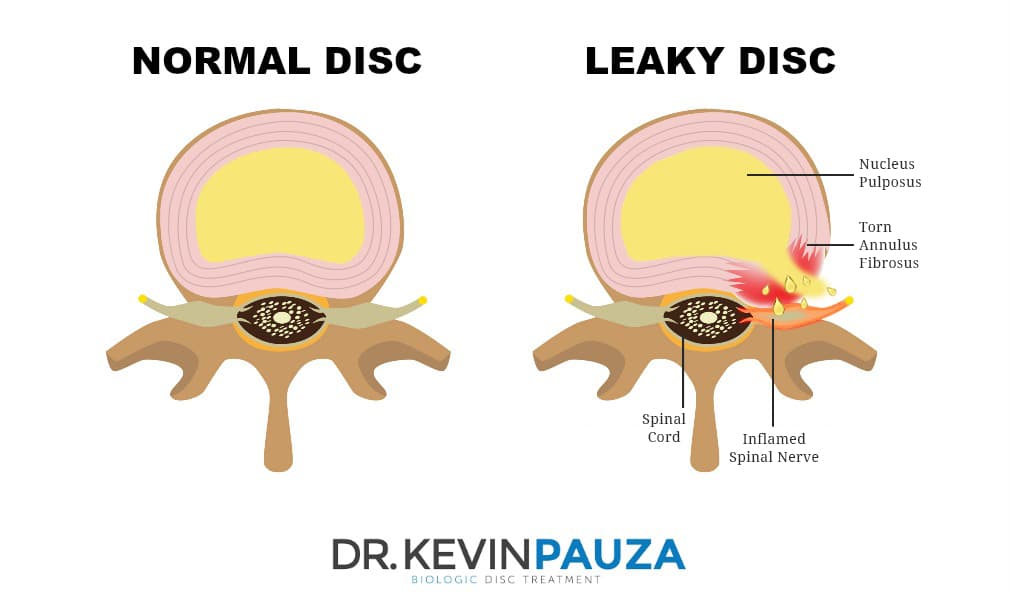A LEADING CULPRIT OF LOWER BACK PAIN IS COMMONLY UNDIAGNOSED BY MANY PHYSICIANS.
If you suffer from chronic low back pain, you have likely run the gamut of searching for solutions only to be left with more questions and mounting frustrations. A major obstacle to successfully diagnosing and treating lower back pain is not understanding that a leaky disc is often the source of your pain. Many patients are diagnosed with Degenerative Disc Disease, however, it isn’t actually a disease—it’s a name given to discs that have degenerated over time from normal wear and tear, causing them to steadily leak and become dark and flat.
Leaky Disc Syndrome™ is a term coined by Dr. Pauza because he found himself continuously explaining to patients how their low back and leg pain was likely caused by annular tears, which allowed the inner portion of the disc to leak onto the spinal nerves, causing inflammation and pain. Many patients are told their symptoms are caused by a compressed nerve. While this is true in some cases, Dr. Pauza believes most pain and numbness experienced in the extremities is caused by leaky discs that have progressed into a herniated and bulged discs.
WHAT IS AN ANNULAR TEAR?
Discs act as cushions or shock-absorbers, between the vertebrae in your spine. They’re composed of a tough, elastic outer layer called the annulus fibrosus that surrounds and protects a thick inner gel, called the nucleus pulposus. It may help to think of discs as miniature jelly doughnuts: exactly the right size to fit between your vertebrae.
When the outer layer of a spinal disc tears from normal wear and tear or injury, it’s known as an annular tear. An annular tear can heal on its own, or it can progress into a herniation or bulge. When it tears, the inner gel substance know as the nucleus pulposus, leaks out of the disc onto the spinal nerves, sometimes causing symptoms of pain and numbness in the back and/or extremities, known as Leaky Disc Syndrome™.
An annular tear is most common in the low back, or lumbar spine because the lower back is responsible for supporting the weight and movements of the body. The discs in the lower back absorb the most impact, allowing the surrounding vertebrae to move and pivot without damage. However, this also increases the lumbar spinal discs’ likelihood of developing Leaky Disc Syndrome™
HOW TO KNOW IF YOU HAVE AN ANNULAR TEAR
The only way to know with certainty whether or not you have a leaky disc is by performing one of two gold standard tests: a Discogram or an Annulargram. Both are procedures conducted through live x-ray guidance whereby Dr. Pauza injects dye into the discs, looking for annular tears. During a Discogram the disc is pressurized in order to see if the pressurization reproduces the patient’s usual pain. During an Annulargram the process is similar, however, the disc is not pressurized. If the dye flows through the disc region, there is obviously a leaky disc.
MRIs do not show annular tears. They do however show herniation, bulges, and degeneration. Many physicians recommend spinal fusions without performing one of these gold-standard tests.
An annular tear and a leaking disc can be the cause of your leg symptoms. Here are some common symptoms and their correlating lumbar location:
- L1/ L2 — Pain, numbness or loss of sensation in the thigh or groin area
- L2/ L3 — Diminished strength in the hip flexor; pain, numbness or loss of sensation in the thighs
- L3/ L4 — Diminished patellar reflex; pain or numbness in the thighs; quadriceps weakness
- L4/ L5 — Numbness or loss of feeling in the feet; diminished patellar tendon reflex; quadriceps weakness; pain in the legs
- L5/ L6 — Numbness or loss of sensation in the feet or toes; weakness in the hips and legs
If you have attempted conservative treatments with no pain relief for longer than six months and the pain is affecting your lifestyle, it may be time for a consultation with Dr. Kevin Pauza to see if the Discseel® Procedure is right for you.


